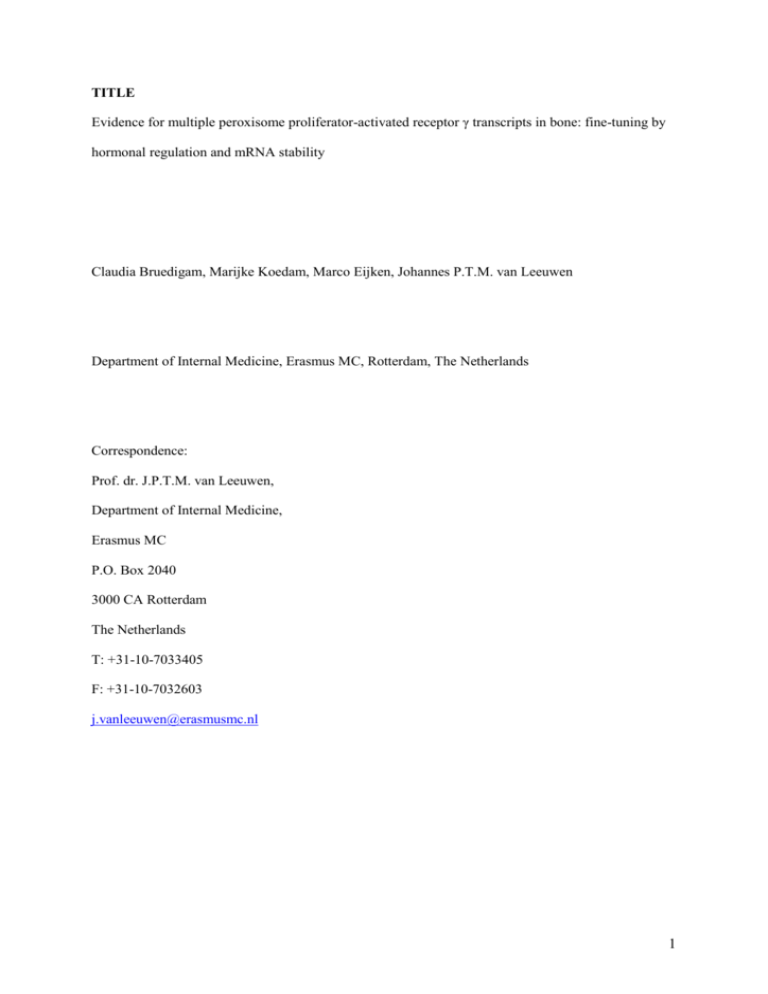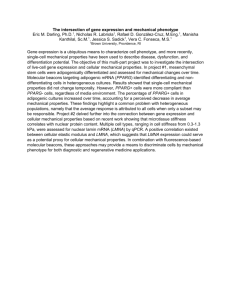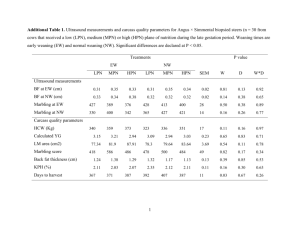Expression of PPARG
advertisement

TITLE Evidence for multiple peroxisome proliferator-activated receptor γ transcripts in bone: fine-tuning by hormonal regulation and mRNA stability Claudia Bruedigam, Marijke Koedam, Marco Eijken, Johannes P.T.M. van Leeuwen Department of Internal Medicine, Erasmus MC, Rotterdam, The Netherlands Correspondence: Prof. dr. J.P.T.M. van Leeuwen, Department of Internal Medicine, Erasmus MC P.O. Box 2040 3000 CA Rotterdam The Netherlands T: +31-10-7033405 F: +31-10-7032603 j.vanleeuwen@erasmusmc.nl 1 KEYWORDS Peroxisome proliferator-activated receptor γ; osteoblast; glucocorticoids; rosiglitazone; mRNA stability; alternative splicing LIST OF ABBREVIATIONS PPARG Peroxisome proliferator-activated receptor γ; DEX dexamethasone; ROSI rosiglitazone; VSMC vascular smooth muscle cells; MSC mesenchymal stem cells ABSTRACT The expression, regulation and functional significance of multiple Peroxisome proliferator-activated receptor γ transcript variants in bone were studied. PPARG transcripts giving rise to PPARg-1 protein were expressed in human osteoblasts, whereas PPARG-2 transcript and protein remained virtually absent. PPARG expression underwent homologous regulation, was upregulated during differentiation and directly induced by the osteogenic hormone dexamethasone, suggesting a role of PPARg-1 for osteogenesis. Differences between the stabilities of PPARG-1, -3 and -4 were observed. We hypothesize that cell-specific expression patterns of multiple PPARG transcript variants encoding for the same protein but differing in mRNA stabilities enable a fine-tuning of PPARG action, which eventually supports a well-adjusted signal transduction between the cell and its environment. INTRODUCTION Peroxisome proliferator-activated receptor gamma (PPARG) is a nuclear transcription factor that plays roles in the control of proliferation, differentiation and survival of various cell types (reviewed in (1)). The single PPARG gene undergoes alternative splicing and promoter usage giving rise to two proteins: PPARg-1 and PPARg-2 (Fig. 1; (2)). PPARg-2 contains an additional N-terminal exon that results in a higher trans-activation capacity compared to PPARg-1 (3). Besides this functional difference at protein level, there is an additional complexity at its transcript level. Interestingly, PPARg-1 protein 2 can be translated from the three PPARG transcripts PPARG-1, -3 and -4 that only differ in their 5’untranslated region (4). The existence of multiple transcript variants encoding for the same protein has been reported for other genes as well (5), but its functional significance has not been revealed yet. PPARg-1 protein is expressed in many cell types, whereas the expression of PPARg-2 is mainly limited to adipocytes (6-8). Also, it has been reported that PPARg-1 is expressed in a murine preosteoblastic cell line (9;10). In this study we investigated the differential expression of the four PPARG transcript variants in human pre-osteoblast and osteoblast-like cells, and in human mesenchymal stem cells (MSCs) that were driven to differentiate towards the osteoblastic lineage. Furthermore the effect of the osteoblast differentiation–inducing hormone dexamethasone (DEX) and the PPARG agonist rosiglitazone (ROSI) on PPARG expression in human osteoblasts were investigated. MATERIALS AND METHODS Cell culture SV-HFO cells (11), normal human osteoblasts (NHOST; Cambrex Bio Science CC-2538, East Rutherford, NJ, USA), human vascular smooth muscle cells (VSMC; Cambrex Bio Science, CC-2583) and human mesenchymal stem cells (MSC; Cambrex Bio Science) were cultured as described previously (12). Short-term incubation studies with dexamethasone, RU-486 or rosiglitazone Medium was supplemented with 10 M ROSI (Cayman Europe; Tallin, Estonia), 100 nM DEX in the absence or presence of 2 M of the glucocorticoid receptor antagonist RU-486 (Sigma) at specific time points (3, 6, 12, 24 and 48 h) before harvest at day 7 of culture. For short-term ROSI incubations, SV-HFO cells were grown in medium as described above. For short-term DEX and RU-486 incubations, SV-HFO cells were grown in the medium as described above with the exception that DEX was not continuously added. 3 Quantification of PPARG transcript expression RNA isolation and cDNA synthesis have been carried out as described recently (13) except that the total amount of RNA was quantified spectrophotometrically using NanoDrop technology (Bancroft Building Wilmington, DE 19810, USA) according to the manufacturer’s instructions. Quantitative real time-PCR (QPCR) was either based on FAM/TAMRA or SYBR Green detection. FAM/TAMRA– based QPCR was performed as described previously (13) with the exception that reaction mixes contained 8 instead of 20 ng cDNA. SYBR Green–based QPCR was carried out using an ABI 7700 sequence detection system (Applied Biosystems, Foster City, CA). Reactions were performed in 25 l volumes using qPCR core kit for SYBR Green I (Eurogentec, Seraing, Belgium). Reaction mixes contained 8 ng cDNA, 3.5 mM MgCl2, 200 M dNTPs, and 0.025 U/l Hot GoldStar enzyme. Primer and probe sequences as well as their concentrations are listed in Table 1. Actinomycin D treatment SV-HFO cells were cultured as described above until day 7 of culture. At 6, 12, 24 and 48 hours before harvesting, actinomycin D (2 g / ml; Sigma) was added to the cultures. Then RNA was isolated and QPCR was performed as described above. Western blotting Cells were solubilized in lysis buffer (M-PER Mammalian extraction kit; Pierce Rockford, IL 61105, USA). Total protein concentrations were quantified using BCA protein assay kit (Pierce). 50 g of total protein extract were loaded on an SDS-polyacrylamide gel consisting of a 5 % (w/v) stacking and a 10 % (w/v) running gel. After electrophoretic separation, samples were transferred to Nitrocellulose blotting membrane (Hybond; Amersham Pharmacia, UK). Unspecific binding sites were blocked using 4 % skim milk in TBS without Tween for over-night at 4 °C. Then, the membrane was incubated in primary antibody solution (primary antibody diluted in TBS with 0,1 % TBS-Tween and 1 % skim milk) for 1 h at room temperature on a roller bank. The dilution for rabbit polyclonal 4 antibody against PPARG was 1:1000 (Cat. 600-401-419; Rockland Gilbertsville, PA 19525 USA). Mouse monoclonal antibody against GAPDH (Cat. MAB374; Millipore) was used as an internal calibrator in a dilution of 1:20000 and incubated for 30 min at room temperature. The membrane was washed four times in 0,1 % (v/v) TBS-Tween and incubated in a diluted secondary antibody solution (secondary antibody diluted in TBS with 0,1 % TBS-Tween and 1 % skim milk) for 1 h at room temperature. The secondary antibodies, anti-rabbit IgG conjugated with IRDye 800CW (Cat. 17122; Rockland) and anti-mouse IgG conjugated with Alexa Fluor 680 (Cat. A21057; Invitrogen) were used in a 1:10000 dilution for 1 h at room temperature to detect the respective primary antibody. After washing the membrane four times in 0,1 % (v/v) TBS-Tween and having removed residual Tween by washing in TBS only, fluorescence was detected and analyzed using LI-COR Infrared Imaging System (Odyssey Lincoln, NE USA). Statistics Data presented are the results of at least two independent experiments performed in at least triplicate. Values are the means ± SEM. Significance was calculated using the Students t-test. RESULTS Expression of PPARG The cell models used all proceed through a differentiation process resulting in the production of a mineralized extracellular matrix in a two- to three-week period (12). PPARG expression was demonstrated during the differentiation of the two human pre-osteoblast cell lines SV-HFO (Fig. 2A), NHOST (Fig. 2B), and MSCs that were differentiated towards the osteoblast lineage (Fig. 2C). In addition, PPARG expression was demonstrated in mineralizing VSMC that are an experimental model of arthrosclerosis (Fig. 2D). The expression of the four PPARG transcript variants PPARG-1, -2, -3 and -4 at various time points during culture was quantified by QPCR. Expression levels of PPARG-1, -3 and -4 were significantly increased during differentiation and mineralization of all the four cell models. PPARG-2 expression, however, was virtually absent in SV-HFO, NHOST and VSMC, and 5 significantly lower compared to PPARG-1 in MSCs (Fig. 2A-D). Interestingly, PPARG expression levels were virtually absent and did not increase in the non-mineralizing condition, i.e. when cells were not stimulated with DEX to differentiate towards a mineralized matrix-producing osteoblast (Fig. 1E). Finally, the presence of PPARg-1 protein and its increase during differentiation (from day 3 to 14 of SV-HFO culture) was confirmed by western blotting (Fig. 2F). Regulation of PPARG expression by short-term dexamethasone treatment Short-term treatment with the synthestic cortisol analog DEX during early differentiation of SV-HFO (day 7) showed already after 3 hours significant increases in expression levels of PPARG transcripts 1, 3 and 4 (Fig. 3). The expression further increased when DEX was added to the medium for 6, 24 and 48 hours before harvest. Induction of PPARG-1, -3 and –4 expression levels was completely blocked by the glucocorticoid receptor antagonist RU-486 (Fig 3). Homologous regulation of PPARG ROSI is a well-studied PPARG agonist and stimulates PPARG signalling in several target tissues (reviewed in (14)). We found that, after short-term treatment with rosiglitazone, PPARG -1, -3 and -4 transcript levels were significantly increased (Fig. 4). PPARG-4 transcript was already significantly induced after 3 h of treatment compared to control (Fig. 4C), and increases in PPARG-3 and -1 expression levels reached significance after 6 or 12 h, respectively (Fig. 4A, B). However, PPARG-2 expression was not induced upon ROSI-treatment (data not shown). Differential dynamics for expression of PPARG splice variants By analyzing the stabilities of the PPARG transcripts using the RNA polymerase II blocker actinomycin D in a time-course experiment, we observed that the stabilities surprisingly differed between the PPARG transcripts 3 and 1 / 4 (Fig. 5). The half-life of the PPARG transcripts-1 and -4 was about 24 hours. The PPARG-3 transcript had about a 6-fold shorter half-life of 4 hours. 6 DISCUSSION The aim of the current study was to assess expression and regulation of PPARG in human osteoblasts. They are bone-forming cells and have the unique function to produce and mineralize an extracellular protein matrix. Osteoblasts undergo several developmental phases through their lifetime: early commitment to organic-matrix production, mineralization and apoptosis or terminal differentiation into an osteocyte. The complex developmental process is orchestrated by the timely activation of specific transcription factors that regulate the expression of their target genes and thus define the osteoblast phenotype (reviewed in (15)). The current study demonstrates increasing expression of the three PPARG transcripts-1, -3 and -4 giving rise to PPARg-1 protein but not PPARG-2 encoding for PPARg-2 protein during differentiation of the two human pre-osteoblast cell lines SV-HFO and NHOST. We furthermore found that PPARG expression was increased during mesenchymal stem cell differentiation towards the osteoblastic lineage. And, finally the observations in the osteoblasts were confirmed in a VSMC-based model for artherosclerosis that mimics matrix formation and mineralization by the osteoblasts. In the absence of differentiation towards matrix producing and mineralizing cells, the PPARG transcript levels are virtually absent and do not increase during culture time. Together these data show a clear coupling between PPARg-1 expression and extracellular matrix synthesis and mineralization indicating a role for PPARg-1 signalling in these processes. Presence of DEX is crucial for all cell models examined to develop into a mineralizing condition (16). Our short-term DEX incubation studies demonstrated that PPARG expression is directly stimulated by DEX. Inhibition by the glucocorticoid receptor antagonist RU-486 suggests that PPARG is a direct glucocorticoid receptor target gene. Our hypothesis is underlined by in silico searches for putative glucocorticoid receptor response elements (GRE) in the promoter region of the PPARG gene, which revealed several hits closed to the transcription start sites (Tatjana Degenhardt; personal communication). However, the identification of functional GRE in the PPARG gene is necessary to better understand PPARG regulation at chromatin level. In addition, our data do not exclude an indirect osteoblast differentiation-driven expression of PPARG because PPARG-1 expression also increases in a DEX-independent differentiating murine osteoblast cell model (9). 7 We demonstrate for the first time in human osteoblasts the presence and regulation of the two additional PPARG transcripts 3 and 4. Moreover, we show that these transcripts as well as PPARG-1 are homologously upregulated. Interestingly, the magnitude of transcriptional regulation by both rosiglitazone and DEX is different between PPARG-1, -3, and -4. This points to a high order of complexity in promoter usage and transcriptional control for these transcripts (Fig. 1). An even higher order of control of transcript levels of these PPARG transcripts is demonstrated by the mRNA stability analyses. Both at transcriptional control and stability the PPARG-3 transcript is the most sensitive. Overall these data support the significance of a precise fine-tuning of PPARG expression in the cell for an optimal function in metabolism. Finally, the differences in stabilities for the three PPARG transcripts -1, -3 and -4 are mechanistically intriguing and yet unexplained. Transcript stability is usually dedicated to the 3’-, but not the 5’-UTR in which these transcripts differ. Thereby the current data suggest also a role for this part of the transcript in stability control. In conclusion, the current study demonstrates that 1) PPARG-1, -3 and -4 transcript levels encoding for PPARg-1 protein increase during differentiation of all four cell models that were used in this study, 2) PPARG expression is directly regulated by DEX, and 3) PPARG regulates its expression itself by an auto-regulatory mechanism. We suggest from this that cell-specific PPARG transcript-variant ratios, due to their specific transcriptional regulation and stabilities, enable a fine-tuning of PPARG receptor-level regulation supporting a well-adjusted signal transduction between the cell and its environment. ACKNOWLEDGEMENTS This work was supported by NucSys, a Marie Curie Research Training Program funded by the European Union (contract number MRTN-CT-019496). REFERENCES Reference List 1. Heikkinen,S., Auwerx,J., and Argmann,C.A. (2007) Biochim.Biophys.Acta. 8 2. Fajas,L., Auboeuf,D., Raspe,E., Schoonjans,K., Lefebvre,A.M., Saladin,R., Najib,J., Laville,M., Fruchart,J.C., Deeb,S., Vidal-Puig,A., Flier,J., Briggs,M.R., Staels,B., Vidal,H., and Auwerx,J. (1997) J.Biol.Chem. 272, 18779-18789. 3. Werman,A., Hollenberg,A., Solanes,G., Bjorbaek,C., Vidal-Puig,A.J., and Flier,J.S. (1997) J.Biol.Chem. 272, 20230-20235. 4. Fajas,L., Fruchart,J.C., and Auwerx,J. (1998) FEBS Lett. 438, 55-60. 5. Leparc,G.G. and Mitra,R.D. (2007) Nucleic Acids Res. 35, 3192-3202. 6. Vidal-Puig,A.J., Considine,R.V., Jimenez-Linan,M., Werman,A., Pories,W.J., Caro,J.F., and Flier,J.S. (1997) J.Clin.Invest 99, 2416-2422. 7. Tontonoz,P., Hu,E., and Spiegelman,B.M. (1994) Cell 79, 1147-1156. 8. Mukherjee,R., Jow,L., Croston,G.E., and Paterniti,J.R., Jr. (1997) J.Biol.Chem. 272, 8071-8076. 9. Jackson,S.M. and Demer,L.L. (2000) FEBS Lett. 471, 119-124. 10. Jeon,M.J., Kim,J.A., Kwon,S.H., Kim,S.W., Park,K.S., Park,S.W., Kim,S.Y., and Shin,C.S. (2003) J.Biol.Chem. 278, 23270-23277. 11. Chiba,H., Sawada,N., Ono,T., Ishii,S., and Mori,M. (1993) Jpn.J.Cancer Res. 84, 290297. 12. Eijken,M., Swagemakers,S., Koedam,M., Steenbergen,C., Derkx,P., Uitterlinden,A.G., van der Spek,P.J., Visser,J.A., de Jong,F.H., Pols,H.A., and van Leeuwen,J.P. (2007) FASEB J. 21, 2949-2960. 13. Eijken,M., Hewison,M., Cooper,M.S., de Jong,F.H., Chiba,H., Stewart,P.M., Uitterlinden,A.G., Pols,H.A., and van Leeuwen,J.P. (2005) Mol.Endocrinol. 19, 621631. 14. Desvergne,B., Michalik,L., and Wahli,W. (2004) Mol.Endocrinol. 18, 1321-1332. 15. Stains,J.P. and Civitelli,R. (2003) Genome Biol. 4, 222. 16. Eijken,M., Koedam,M., van Driel,M., Buurman,C.J., Pols,H.A., and van Leeuwen,J.P. (2006) Mol.Cell Endocrinol. 248, 87-93. FIGURE LEGENDS 9 Figure 1 Exon-intron structures of multiple PPARG transcripts. Exons are depicted as grey squares and separated from each other by intronic sequences (black lines). The positions and sizes do not match real scale. Sequences underlying this figure were received from the NCBI database (received at 12, 11, 2007 from the NCBI on-line database / Entrez Gene, http://www.ncbi.nlm.nih.gov). Figure 2 Expression levels of multiple PPARG transcripts encoding for PPARg-1 protein increase during differentiation of human osteoblasts and osteoblast-like cells. Q-PCR of PPARG transcripts 1-4 in the human pre-osteoblast cell lines SV-HFO (A) and NHOST (B), human bone marrow-derived mesenchymal stem cells differentiated towards osteoblasts MSC (C), human vascular smooth muscle cells VSMC (D), and SV-HFO grown on medium lacking the osteogenic differentiation factor DEX (E). Expression levels are relative to the housekeeping gene GAPDH. Values are the mean of at least three biological replicates ± SE. Western blotting of PPARg-1 (upper band) in SV-HFO at day 3 and 14 of culture (F). GAPDH (lower band) was used as loading control. 3, 14: SV-HFO culture days 3 and 14, respectively; L: Protein standard Figure 3 Glucocorticoid receptor-regulated expression of PPARG. SV-HFO cells were short-term incubated with the cortisol analog DEX and/or the glucocorticoid receptor antagonist RU-486 at day 7 of culture. Transcript levels were measured using QPCR. Values are relative to the housekeeping gene GAPDH and the mean of at least three biological replicates ± SE. Asterisks (*) denote values that were determined to be significantly (p ≤ 0.05) different from those of control. 10 Figure 4 Homologous regulation of PPARG. Rosiglitazone was added to the SV-HFO cultures at distinct time points before harvest at day 7. Transcript levels were measured using QPCR. Values are relative to the housekeeping gene GAPDH and the mean of at least three biological replicates ± SE. Asterisks (*) denote values that were determined to be significantly (p ≤ 0.05) different from those of control. Figure 5 Differential stabilities of the three PPARG transcripts PPARG-1, -3 and -4 encoding for PPARg-1 protein. The polymerase II inhibitor actinomycin D was added at 6, 12, 24 and 48 h before harvest at day 7. Data have been obtained by QPCR. Values are expression levels relative to GAPDH, and normalized to control. 11 FIGURES Figure 1 12 Figure 2 13 14 15 Figure 3 16 17 Figure 4 18 19 Figure 5 20





